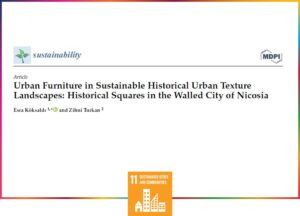
A study conducted by researchers Köksaldı and Türkan from Near East University delves into the historical city textures of Nicosia, focusing on Asmaaltı and Selimiye Squares within the walled city center. These squares, deeply rooted in the cultural heritage of Cyprus, serve as significant cultural heritage areas shaped by diverse civilizations throughout history.
The study evaluates the urban furniture within these squares, analyzing its material, shape, functionality, and conformity with the historical texture. Findings reveal that much of the urban furniture lacks compatibility with the traditional characteristics of the texture, primarily due to its modern construction materials and poor maintenance.
Based on these observations, the research proposes a set of recommendations aimed at enhancing the integration of urban furniture with the historical city texture. These recommendations include the use of traditional materials, such as wood and iron, for seating units, lighting elements, boundary elements, and bins. Additionally, flower beds should be made of wood and incorporate culturally relevant plants, while top cover elements should take the form of pergolas and arbors integrated with vine plants.
The study emphasizes the importance of incorporating user opinions and co-creation practices in the design and renovation process of public spaces. It highlights the need for sustainable preservation and renovation activities that consider historical identity, social functions, and the merging of modern and traditional building materials.
Furthermore, the research underscores the role of historical urban textures as open-air museums, providing a glimpse into the past and fostering appreciation for former craftsmanship and creativity. It advocates for a holistic approach to renovation work, leveraging digital technological tools and involving both professionals and users to ensure a stronger sense of ownership, cooperation, and sustainability in public spaces.
Overall, the study contributes valuable insights into the preservation and enhancement of historical city textures, emphasizing the importance of integrating urban furniture in a manner that respects and reflects the rich cultural heritage of the region.
More Information:
https://www.mdpi.com/2071-1050/15/12/9236